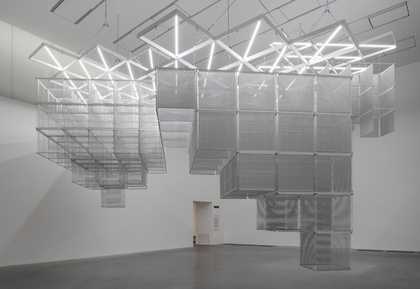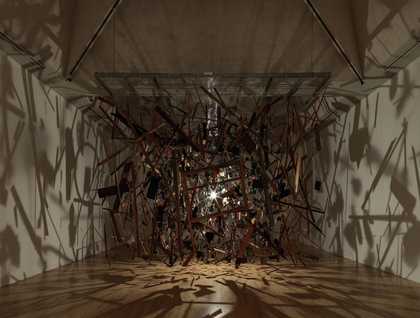Introduction
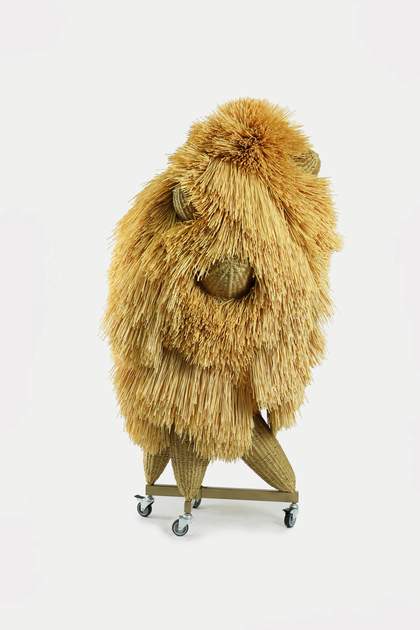
Haegue Yang The Intermediate – Tilted Bushy Lumpy Bumpy 2016. Marc and Annette Kemmler Collection. Photo Studio Haegue Yang
Haegue Yang is an uncanny artist with ever-evolving curiosities. Reflecting a wide range of interests, her works often seem difficult to bring under a single way of reading. The concept of chaos also shares a similar quality of resisting prediction and classification. Yet despite its variability, chaos is also attracted to strange behaviours. This exhibition borrows its title from the scientific study of ‘strange attractors’, the unexpected structures towards which chaotic systems tend to evolve.
Strange Attractors considers our universal human venture within chaotic and unpredictable futures. Across three galleries, Yang navigates humankind’s spiritual, cultural and artistic responses to the natural world and its phenomena. Seemingly disparate ideas and practices become aligned across histories, geographies and time periods. Gallery 6 is transformed into a universe where sciences and mathematics become synchronised with systems of belief, value and artistic abstraction. Yang’s creature-like sculptures inhabit the mystical and geometric landscapes where natural phenomena are captured and activated through motion, sound and light.
Historic works by artists Li Yuan-chia, Barbara Hepworth and Naum Gabo are displayed in gallery 5, selected by Haegue Yang with Anne Barlow, Director, Tate St Ives. The display connects the lives and works of these pioneering modern artists across eras and locations. Continuing in gallery 8, Yang explores acts of folding, unfolding and non-folding. Views of the coastline become interrupted with changing optical patterns, and familiar objects are present through only the imprints they leave behind.
Li – Hepworth – Gabo
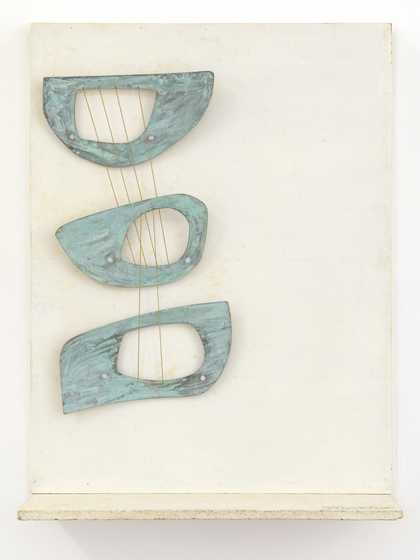
Dame Barbara Hepworth
Maquette, Three Forms in Echelon (1961)
Tate
This modest display in gallery 5 is dedicated to Li Yuan-chia (1929–94), Barbara Hepworth (1903–75) and Naum Gabo (1890–1977). Through the works and legacies of these artists, Yang invites us to consider where diverse cultural heritages are unique or closely aligned.
Li, Hepworth and Gabo all journeyed and worked internationally. Gabo was born in Russia and travelled extensively before his move to Britain in the 1930s and his later migration to the United States. British-born Hepworth worked in proximity with Gabo in St Ives, especially during the Second World War. Li was born in China and educated in Taiwan. He lived in Italy and London before settling in Cumbria, in the north-west of England. There, Li established the LYC Museum & Art Gallery. He exhibited the works of hundreds of artists, including Gabo and Hepworth.
In the imprint of these artists, Yang visited St Ives in 2018 and travelled to the LYC Museum and Art Gallery. In displaying these artists together, they once again occupy the same ‘orbits’ without being personally present. This presentation of works suggests an unfolding conversation between Li, Hepworth, Gabo, Yang and ourselves.
The Intermediates
Weaving with natural materials is a practice found across civilisations. The Intermediates borrow plant-working techniques and customs from multiple cultures to reflect on unique and universal ideas of ‘folk’. The hybrid works are developed beyond defined conventions, to appear at once ancient, omnipresent and futuristic.
The skilled craftsmanship of The Intermediates contrasts with Yang’s choice of synthetic, cheap, industrial and commercial materials. Incorporating labour-intensive processes with low-cost products, the sculptures transcend traditional distinctions of value, authenticity and meaning. Earlier versions, begun in 2015, employed products that emulate natural straw. The series later diverted from this imitation of the ‘real’, to incorporate black and white cords. This tendency to drift away from one’s own logic, or unlearn a self-established rule, is characteristic of Yang’s work.
Sonic Intermediates – Three Differential Equations
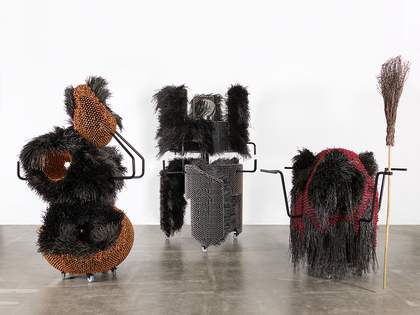
Haegue Yang Sonic Intermediates. Photo Nick Ash
This tri-part sculpture represents a speculative encounter between Li Yuan-chia, Barbara Hepworth and Naum Gabo. The three totemic entities embody Yang’s subjective reading of these influential modern artists.
One form evokes Li’s self-portrait photography, another echoes Hepworth’s sculptures, and a third alludes to Gabo’s machine-oriented constructions. The relationship between these artists appears historically remote and not strongly associated, yet Yang brings the three figures into conversation beyond the conventions of era and place. We are invited to encounter this trio of great artistic minds as an openended collective, of which we – the viewers – are part.
Newly conceived for this exhibition, the hairy Sonic Intermediates – Three Differential Equations marks the birth of a hybrid category combining Yang’s Sonic Sculptures and The Intermediates.
Mundus Cushion – Yielding X
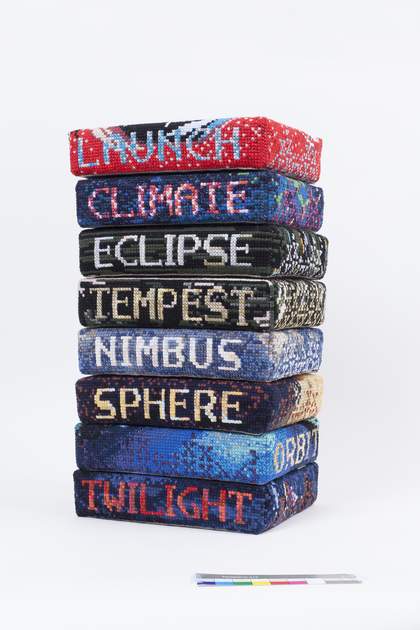
Haegue Yang Mundus Cushions – Yielding X 2020. Photo Studio Haegue Yang
Mundus Cushion — Yielding X refers to our contemporary wishes and worries for the ’mundus’ (a latin word for ‘world’ or ‘universe’).
This Furniture Sculpture was inspired by Yang’s 2018 visit to St Senara’s Church, in Zennor, near St Ives. St Senara’s kneeler cushions depict intimate and everyday images alongside traditional and sacred symbols. The modest motifs convey this community’s profound relationship with nature and landscape. The humble wishes and concerns that Yang found inscribed on these cushions mirror the hopes and anxieties expressed at many sacred sites.
Borrowing traditional needlework techniques, Yang’s kneeler cushions honour the collective skills and labour of this Cornish coastal community. Raised upon an X-shaped bench, they depict fluctuating and chaotic systems of natural phenomena that hold eternal and contemporary significance.
Sonic Half Moons
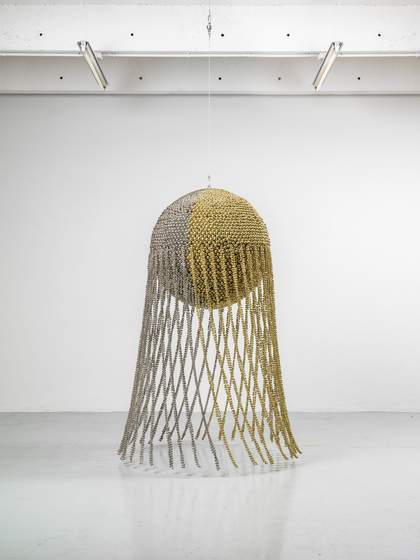
Haegue Yang Sonic Half Moon Type III – Large Light #22 2015. Photo Florian Kleinefenn
Appearing like planetary objects, Sonic Half Moons 2014–15 are suspended from the ceiling and periodically rotated by hand. When activated, the studded surfaces and skirts of metal bells become a spinning system of pulsing sound and light.
In motion, the suspended spheres rattle and realise their potential to emit sound. Hanging tentacles self-choreograph as they revolve and swing, transforming with reflected light. Appearing initially unstable and chaotic, patterns of sound and movement establish then dissipate over time. Responding to variations in manual activation, available light and local conditions, Sonic Half Moons reveal chaotic beginnings which evolve towards mathematical order and interconnected behaviours.
Non-linear and Non-periodic Dynamics
Fascinated with the energies of ‘movement’, Yang also investigates attributes of ‘flatness’. Compressing tiers of digital images into a wallpaper surface, an ‘environment of layered flats’ is created within the three dimensional gallery space. Abstracted photographs of coastlines reference Yang’s visits to ancient settlements and sacred places in Cornwall, in 2018, and the foggy, windy and wet weather.
Wild coastal landscapes and climate conditions are presented as dynamic circular cut-outs. Images are turned and spun around as if travelling through place, time and space. Ominous elements of crashing oceans, rapid-moving water and natural phenomena lose their connection to specific locations. A mirrored shape resembles the ‘Lorenz attractor’ (butterfly effect), reminding us that small actions and events have the potential to create significant impacts, elsewhere.
Lacquer Paintings
Initiated in 1994, Yang’s Lacquer Paintings record and fix various locations and periods of time. They are produced over summer and left to develop in unpredictable outdoor conditions. The slow-drying surfaces capture the effects of ambient weather and climate to create unrepeatable prints of the environment.
Referencing lacquerware traditions from Asia, Yang embeds objects into layers of cheap household varnish. Incidental particles of dust, hairs, plant matter and insects fall onto the wet lacquer as it slowly dries. Stray rain marks and other environmental factors further transform the surfaces. These local events manifest within the work and indicate the flow of time and seasonal, cyclical changes.
Trustworthies
This ongoing series, begun in 2010, collages standardised sheet materials such as graph paper, sandpaper, vinyl, and the security patterns found inside envelopes. Through mutations of colour, pattern, composition, and proportion, Yang suggests alternative possibilities for these familiar paper products.
Two new Trustworthies were developed for this exhibition. They draw on visual and abstract systems that reflect Yang’s impressions of West Cornwall. Inspired by the area and its cultural and historical relationships with water, the images incorporate structures and patterns found in coastal cliffs, dams, fishing cages, trap floats, and water buckets, mops, and taps.
Reflected Metallic Cubist Dancing Mask
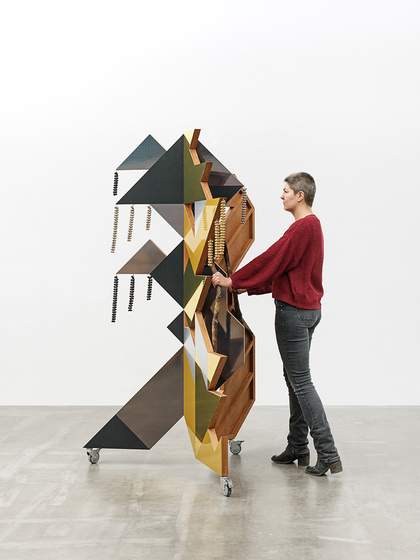
Haegue Yang Reflected Metallic Cubist Dancing Mask 2020 Courtesy of Galerie Chantal Crousel, Paris. Photo Nick Ash
This outsized, movable mask originates from Yang’s interest in culturally shared ritual objects and actions. Like the shaped wall elements, the internal structure of the mask is left uncovered with its skeleton intimately exposed. In contrast to its unclad back, its face is dressed with metallic and reflective vinyls.
Reflected Metallic Cubist Dancing Mask presents as a theatrical prop or character, or perhaps a shield or façade to hide behind. Casters and handles imply the sculpture can be activated to move or dance through human intervention. Implicated as a performer, the dormant mask also appears to await a partner and the opportunity to collude and transform identities.
Non-folding – Geometric Tipping
Negative space embodies a sense of loss, but also the idea of ‘the rest’ and what remains. In negative space, shadows and silence become families of entities that inhabit the imperceptible zones.
Haegue Yang 2020
Origami is the art of transforming a flat sheet of paper into a three-dimensional object by repeated acts of folding. Yang’s interest lies in geometric unit folding as an exploration of mathematics and abstraction.
Polygonal origami objects are laid onto paper and repeatedly flipped and turned. As they travel across the paper each new position is captured in a veil of spray-paint. The spray traces the contour of the form and painted shadows emerge onto the paper. The absent object becomes recorded in a state of flatness without unfolding its physical, three-dimensional form.
Non-Indépliable, nues
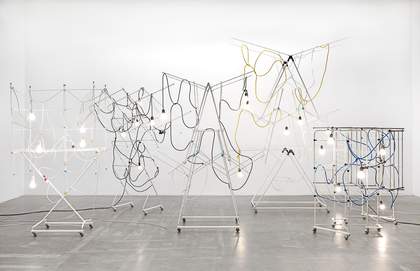
Haegue Yang Non-Indépliables, nues, 2010/2020. Drying racks, light bulbs, cable, zip ties, terminal strips. Courtesy the artist. Photo: Nick Ash.
The drying rack has appeared multiple times in Yang’s work, mostly as a symbol of basic activities such as resting, washing, cooking and cleaning. Taking references from domesticity, Non-Indépliables, nues endow new character to these familiar objects.
Laundry racks are stacked and dressed in strings of light bulbs and electric cords. The entwined strands also disrupt the racks’ ability and function to collapse or unfold; they become physically ‘non-unfoldable’ (in French, ‘non-indépliable’). Lit by a power source, the sculptures hold and transmit energy, light and shadow. Their generated light interplays with the natural sunlight cast through the mesh curtain element. The energised racks emerge as sculptural beings with the potential to metamorphose and unfold.
Elements
A series of architectural elements create mystical possibilities within the gallery spaces.
Defining areas and pathways, triangular walls borrow the geometric motif of the Philippine Binakol pattern. The optical pattern symbolises waves and whirlpools. It is believed to confuse malevolent spirits and defend against the recurring, seasonal catastrophes of heavy rains and floods.
Sequences of wall-based ‘handles’ suggest doorways to unknown worlds. The door handles are organised in a matrix of nonagonal (nine-sided) shapes derived from George Gurdjieff’s (1866–1949) Enneagram. Based on an ancient symbol, the philosopher and spiritual guru considered the pattern as ‘the fundamental hieroglyph of a universal language’.
The sea-facing gallery 8 is activated by transparent curtains that cloak the windows and affect changes in light. The shifting layers of woven mesh modify the view beyond with a changing, optical effect.
Supported by Henry Moore Foundation and Institut für Auslandsbeziehungen. With additional support from Kvadrat, Tate Members and Tate St Ives Members. With thanks to the Li Yuan-chia Foundation and Studio Haegue Yang in Berlin and Seoul.

